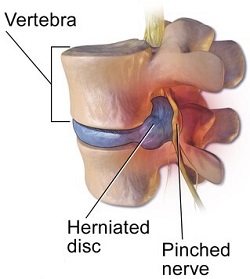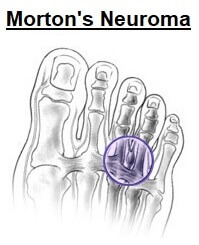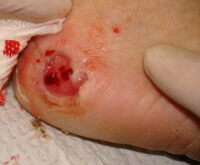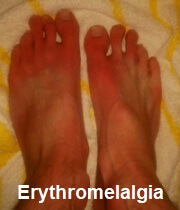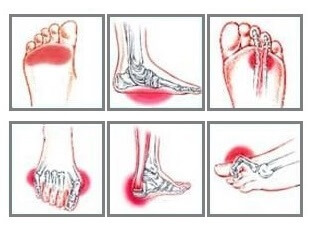- Home
- Foot Pain Symptoms
- Burning Foot Pain
Burning Foot Pain
Written By: Chloe Wilson BSc(Hons) Physiotherapy
Reviewed By: FPE Medical Review Board
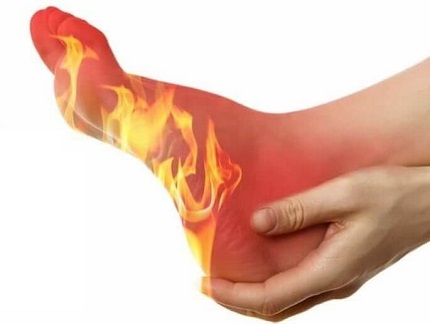
Burning foot pain is a common complaint, usually as a result of damage to the nerves of the foot or leg.
Burning pain in the feet and toes may develop due to an injury or medical condition either of which can cause compression of the nerves.
Our nerves are the structures that carry messages to and from the brain. They tell our muscles when and how to work and are responsible for sensation including pressure and temperature. Damage to the nerves affects how these signals are transmitted resulting in abnormal sensations.
Burning foot pain symptoms may be constant or come and go, vary in intensity and be accompanied by other sensations such as pins and needles or numbness. It all depends on what is causing the problem.
Causes of Burning Foot Pain
Here we will look at the most common causes of burning pain in feet, how they present, what causes them and how they are treated.
1. Peripheral Neuropathy
One of the most common causes of burning foot pain is peripheral neuropathy.
Peripheral neuropathy is caused by damage to the nerves in the leg or foot, anywhere along their path from the spine down to the feet. Peripheral neuropathy is the most common cause of burning pain in feet
Causes: Various medical conditions e.g. diabetes, injury e.g. fractures, infections e.g. shingles or medication. In approximately 30% of cases the cause is unknown
Symptoms: Burning foot pain often accompanied by weakness, altered sensation e.g. pins and needles or numbness, altered balance and co-ordination. It tends to affect both feet at the same time. Symptoms may come and go or get progressively worse
Treatment: Treatment will vary depending on the specific cause of the peripheral neuropathy.
Find Out More: Foot Nerve Pain
2. Morton’s Neuroma
Another possible cause of burning foot pain that extends to the toes is a Morton's Neuroma.
With a Morton's neuroma there is thickening of the soft tissues surrounding one of the nerves in your foot. This can lead to pressure on the nerve which result in a burning pain in the toes and in the ball of the foot.
Causes: Anything which places pressure on the foot such as abnormal foot position, repetitive high-impact activities e.g. running or poor fitting footwear e.g. narrow shoes or high heels
Symptoms: The most classic symptom of a Morton's neuroma is that it feels like you are standing on a pebble. This may also be associated with burning foot pain in the ball of your foot, burning toes and numbness
Treatment: Rest, ice, anti-inflammatory medication, good-fitting shoes (preferably wide and flat), orthotics, injections, surgery
Find Out More: Mortons Neuroma
3. Charcot-Marie-Tooth Disease
Charcot-Marie-Tooth Disease is a group of disorders that affect the peripheral nerves and can result in a burning foot in the feet.
Causes: CMT is an inherited disorder caused by genetic mutation
Symptoms: Foot drop (inability to lift the foot up straight), high foot arches, muscle weakness, burning pain in foot, numbness and poor balance
Treatment: There is no known cure for CMT disease but treatment aims to improve functional ability through exercises, orthotics, braces and occasionally surgery.
Find Out More: Charcot Marie Tooth Disease
4. Metatarsalgia
Metatarsalgia can also cause burning pain in the feet due to irritation and inflammation of the metatarsal foot bones and surrounding soft tissues.
Causes: Overuse (e.g. lots of walking/running), repetitive stress, muscles weakness and tightness, poor-fitting footwear, abnormal foot position e.g. bunions, stress fractures, gout
Symptoms: Burning foot pain in the ball of the foot, most commonly under the big toe, worse with standing or walking. Burning pain in feet tends to come on gradually over time rather than suddenly
Treatment: Rest, ice, exercises, orthotics e.g. metatarsal pads, medication
FIND OUT MORE: Metatarsalgia Foot Pain
5. Peripheral Vascular Disease (PVD)
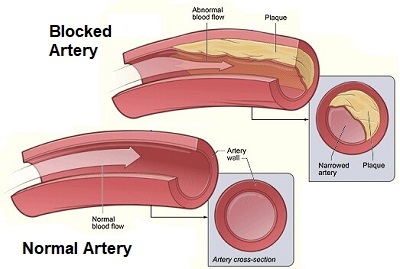
One of the more potentially serious causes of burning pain in the feet is Peripheral Vascular Disease.
This is where there is an obstruction of one or more of the large arteries of the extremities, i.e. those not around the heart or brain, which limits blood flow. It is also known as peripheral artery disease (PAD)
Causes: Atherosclerosis (thickening of the artery wall), stenosis (narrowing of the artery) or a blood clot. Prevalance increases with age
Symptoms: Burning foot pain especially when walking, weakness, muscle cramp, sores or ulcers, changes in skin colour (usually blue/purple), decreased hair and nail growth. May affect one or both feet. Symptoms usually get worse with activity and improve with rest
Treatment: Treatment for PVD aims to control the symptoms and stop progression of the disease. It usually involves modifying your lifestyle such as regular exercise, stopping smoking and a healthy diet, treatment of associated conditions such as diabetes, medication and in some cases surgery
6. Tarsal Tunnel Syndrome
Another possible cause of burning on the side of the foot is Tarsal Tunnel Syndrome. With tarsal tunnel syndrome, there is compression of the tibial nerve as it passes through the tarsal tunnel (a space between the foot bones) on the inner side of the foot near the ankle
Causes: Bone spurs, tumour, foot swelling, ganglion cyst
Symptoms: Burning foot pain on the side and bottom of the foot, pins and needles, numbness in the heel and toes. Usually only affects one foot
Treatment: Rest, exercises, medication, injections and occasionally surgery
Find Out More: Tarsal Tunnel Syndrome
7. Diabetic Neuropathy
Another possible cause of burning pain in the foot is Diabetes. Diabetic neuropathy is a serious complication of Diabetes which damages the nerves causing peripheral neuropathy.
Causes: Prolonged high blood sugar levels damage the blood vessels that supply the nerves with oxygen and nutrients and affect how the nerves transmit signals
Symptoms: Symptoms usually start in the feet and legs and can spread to the hands. Tingling, numbness, burning foot pain often worse at night, hypersensitivity, muscle weakness, ulcers
Treatment: Medication, strict monitoring and control of blood sugar levels, healthy diet, exercise, avoid smoking and excessive alcohol intake
Anyone suffering from Diabetes should take extra care of their feet, examining them daily for any problems. The loss of sensation in the foot often results in foot problems going unnoticed.
8. Chronic Regional Pain Syndrome
One of the less common causes of burning foot pain is chronic regional pain syndrome (CRPS).
CRPS is a chronic (long-term), progressive disorder caused by dysfunction and over-sensitisation of the nervous system where peripheral nerves send inappropriate pain signals to the central nervous system. Previously known as Reflex Sympathetic Dystrophy (RSD), it is the most painful form of chronic pain.
Causes: CRPS is poorly understood but it is thought to be caused by the body responding inappropriately to an injury and a resultant inflammatory response. There are two types of CRPS defined by the initial cause, type 1 (the most common) develops after a soft tissue injury (often minor such as a sprain), disuse or crush injury, type 2 develops after a nerve injury
Symptoms: Intense, constant, extreme burning foot pain that is much greater and lasts longer than would be expected after the initial injury. Associated swelling, spasms, changes in skin temperature (e.g. excessive sweating), redness, allodynia (hypersensitivity to light touch), stiffness, sleep disturbance and affected mood. Starts in one limb but often spreads.
Treatment: There is no known cure for CRPS. Treatment aims to reduce the symptoms such as burning foot pain and includes medication (painkillers and anti-depressants), physiotherapy, nerve blocks, exercise and counselling
9. Erythromelalgia
Erythromelalgia is a rare neurovascular disorder where blood vessels get intermittently blocked resulting in burning pain in feet
Causes: A problem with the neuropathological and microvascular systems
Symptoms: The most defining symptom is redness of the foot with associated swelling and burning foot pain
Treatment: Treatment usually involves medication and cooling down the foot by removing socks. However, sufferers of Erythromelalgia are advised against using cold water baths to cool down their feet as it can cause longer term damage
10. Burning Feet Syndrome
Burning Feet Syndrome is a medical condition, also known as Grierson-Gopalan Syndrome, where there is damage to the small nerve fibres of the foot
Causes: There is often no clear cause but it is thought to be linked with factors such as vitamin B deficiency, diabetes, hypothyroidism, rheumatoid arthritis, renal failure and abnormal foot biomechanics. There is also thought to be a genetic link
Symptoms: Burning foot pain, usually on the soles of the feet but occasionally spreading up the lower leg which is worse at night-time. Sometimes accompanied by pins and needles and numbness. In most cases there is no redness or tenderness in the affected region. It can also cause affect vision.
Treatment: Cold water foot baths, vitamin B supplements, comfortable footwear
Other Causes of Burning Foot Pain
There are a number of other causes of burning foot pain including:
- Gout Foot: with gout, there is a build up of uric acid forms crystals in the joints which causes sudden swelling, redness and intense burning pain in the foot, particularly the big toe
- Tendonitis: inflammation or degeneration of one of the foot tendons can cause a burning pain in the foot. The location of symptoms will depend which tendon is affected e.g. peroneal tenonitis causes burning pain on the outside of the foot and extensor tendonitis causes top of foot burning pain
- Alcoholism: Excessive alcohol intact can cause nerve damage resulting in burning pain in feet
- Chronic Kidney Disease: Toxins may cause burning pain in feet
- Hypothyroidism: Low levels of thyroid hormones can lead to swelling which places pressure on nerves resulting in burning foot pain, pins and needles and numbness
- HIV/AIDS: Approximately one third of people with HIV/AIDS suffer from painful nerve damage which can result in burning in the feet
- Vitamin Deficiency: A deficiency of vitamin B12 can cause burning pain in feet
- Chemotherapy: Some types of chemotherapy cause a condition known as palmar-plantar erythrodysesthesia (aka hand-foot syndrome). Common symptoms include swelling, redness and burning pain on the soles of the feet or palms of the hand and ulcers
When Is Burning Foot Pain Serious?
In most cases, burning foot pain is nothing major to worry about but there are a few situations where it may be a sign of a serious condition such as a TIA (transient ischaemic attack), stroke or blood clot.
Burning pain in feet which develops suddenly should always be seen as a medical emergency to rule out these serious possible causes. And remember, always get any new incidence of pain checked out by your doctor.
Burning Foot Pain Summary
There are lots of possible causes of burning foot pain:
Burning foot pain that affects the whole foot is usually caused by peripheral neuropathy or burning feet syndrome, but may also be due to CMT, CRPS, peripheral vascular disease, erythromelalgia or diabetes.
Burning pain in toes may be from morton's neuroma, metatarsalgia, gout or nerve damage.
Burning on top of the foot is usually caused by peripheral neuropathy, extensor tendonitis or mortons neuroma
Burning pain outside of foot may be due to peroneal tendonitis or stress fractures
Burning on the inner side of the foot may be due to tarsal tunnel syndrome, posterior tibial tendonitis or nerve damage,
If none of these is sounding quite like your problem, visit the foot pain diagnosis section for help working out what is going on.
You may also be interested in the following articles:
- Pain On Top Of Foot
- Foot Arch Pain
- Nerve Pain In The Foot
- Foot & Ankle Stretches
- Swollen Feet & Ankles
- Foot Numbness
- Why Are My Feet Red?
Related Articles
Page Last Updated: 2nd January, 2025
Next Review Due: 2nd January, 2027
